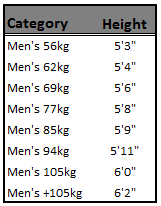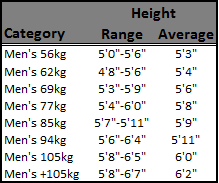Dip N' Drive
The Sport of Weightlifting
Category Archives: Uncategorized
Height and Bodyweight
Posted by on February 18, 2014
Weightlifting requires muscles. Here are pictures of the Gold medalists in the 56kg, 62kg, 77kg, 105kg, and 105+kg weight classes at the 2013 Worlds. None of those guys is skinny, lanky, or lithe.
So what weight class do you need to get to at a given height? The following chart uses the data from All Things Gym and their post on London 2012 Weightlifting Athletes Statistics. It averages the heights for all 158 weightlifting athletes at the 2012 Summer Olympics in London.
While these are ideals, they’re not going to hold for less elite lifters. A local weightlifter is not going to be as thin and muscular as Lu Xiaojun. Even within the London data set, there is wide variety.
At 5’9″ I should be smack dab in the middle of both the 77kg class and the 85kg class. Right now, I’m about 83kg. I need to gain another 10 pounds to get the most out of my height (more specifically lose ten pounds and gain twenty). Very tall lifters won’t get the most out of their longer levers without gaining significant weight (105kg is 231 pounds). I have a client who is 6’3″ 185″ and he’s just too lanky to really feel comfortable weightlifting, at least for now.
USAW Sports Performance Certification, Part 1
Posted by on February 12, 2014
I took the USAW Sports Performance Certification Class over Super Bowl weekend, at Reebok One in NYC. There were ten Reebok One trainers with varied past experience with the lifts, a CrossFit guy and me. The facility was a four or five story gym with classes, courts, all manner of machines, free weights, a cafeteria and more. It was a great space to use with plenty of room to work.
The instructor broke the two days into four sections: (1) classroom time Sat AM (2) barbell time Sat PM (3) barbell time Sun AM (4) classroom time Sun PM. Saturday morning lasted from 8:30 to 1:00 and covered all the written material on the lifts themselves, including why and how we do them. There was plenty of discussion among the group and the instructor let us talk freely. Saturday afternoon meant practical work with a bar in our hands. From 1:30 to 5:45 we warmed up, reviewed progressions of the three lifts, and took our clean (no jerk) to a max for the day, while the instructor and his assistant coached and corrected us. Sunday morning was 8:30 to noon and covered the squatting, pulling and pressing exercises, though nothing heavier than 50%. We also had a ‘practical review’ where each of us coached someone else on one of the three lifts. Sunday afternoon we talked program design, and reviewed and took the test. The test is nothing to worry about. You should pass without a problem. The instructor makes certain that you are prepared.
Instructor Mike McKenna is this one, not this CrossFit one. Funny and friendly, he had a ton of stories to share about recent or past weightlifting history relevant to the point at hand. There was lots of discussion during the classroom times and plenty of back and forth on the hows and whys. His opinions flowed freely about the various characters of the wider weightlifting world. The only one I will share is his recommendation of Spencer Arnold as the best of the free online programming to follow. He prepared us well for the test, emphasizing the critical issues, and I felt confident while taking it.
After this class, I feel much more comfortable introducing my clients to weightlifting. Like any certification, it doesn’t mean you’re magically a capital-C Coach. But it sets you up with the tools for success to spread the gospel of weightlifting to the masses safely and effectively.
For instance, to get the boxer I train doing power cleans, the stated progression is:
- Front Squat
- Power Clean from Power Position
- … from Hang Above Knee
- … from Below Knee
- … Lift Off (going from setup to the knee)
- … from Floor
Getting him to master those positions, first with an empty bar and slowly with added load, should set him up to move well and not ingrain any bad motor patterns. I wouldn’t have known how to approach this before, and probably would have had him doing crappy power cleans, slowly correcting each mistake one by one. The progressions ensure that everything is in place and I can focus on fewer mistakes at a time.
As an individual lifter, I felt the course was helpful, but not necessary. However as an aspiring coach, the course is a great foundation for teaching the lifts.


Recent Comments